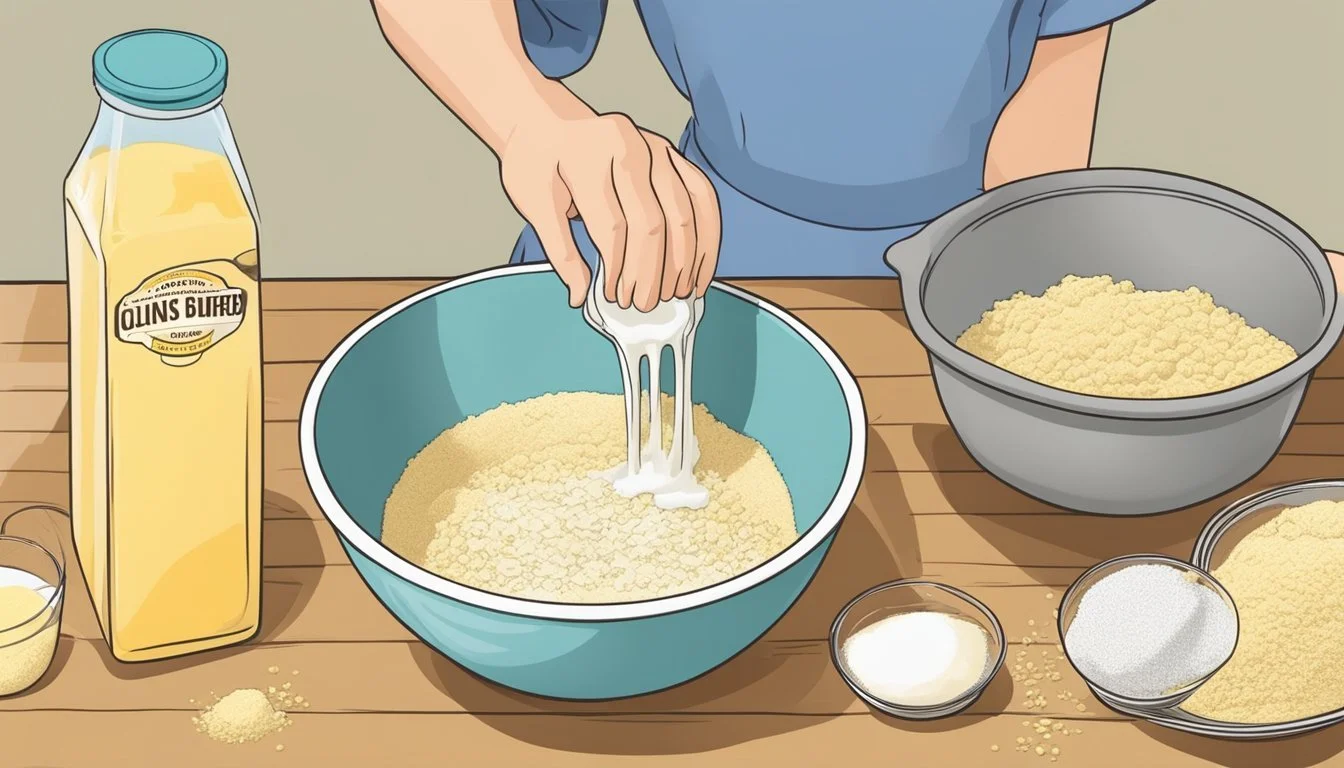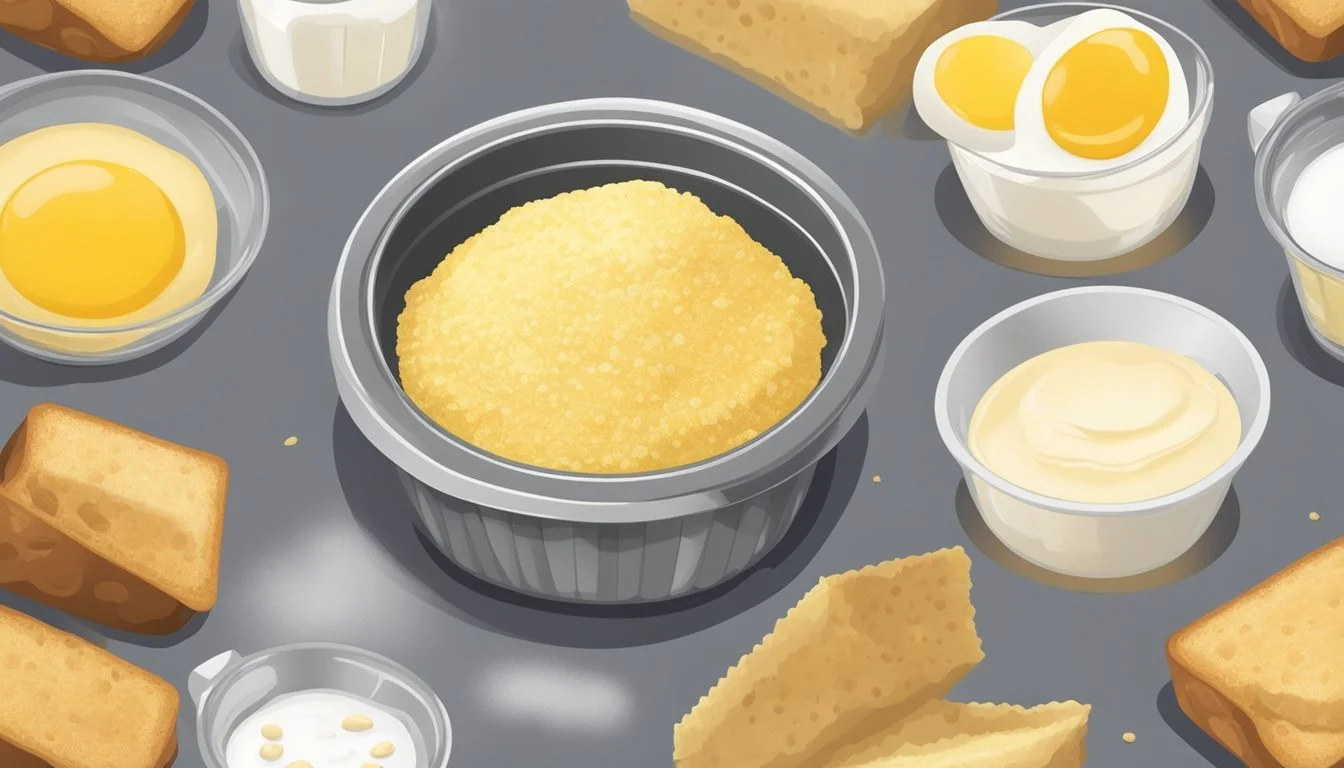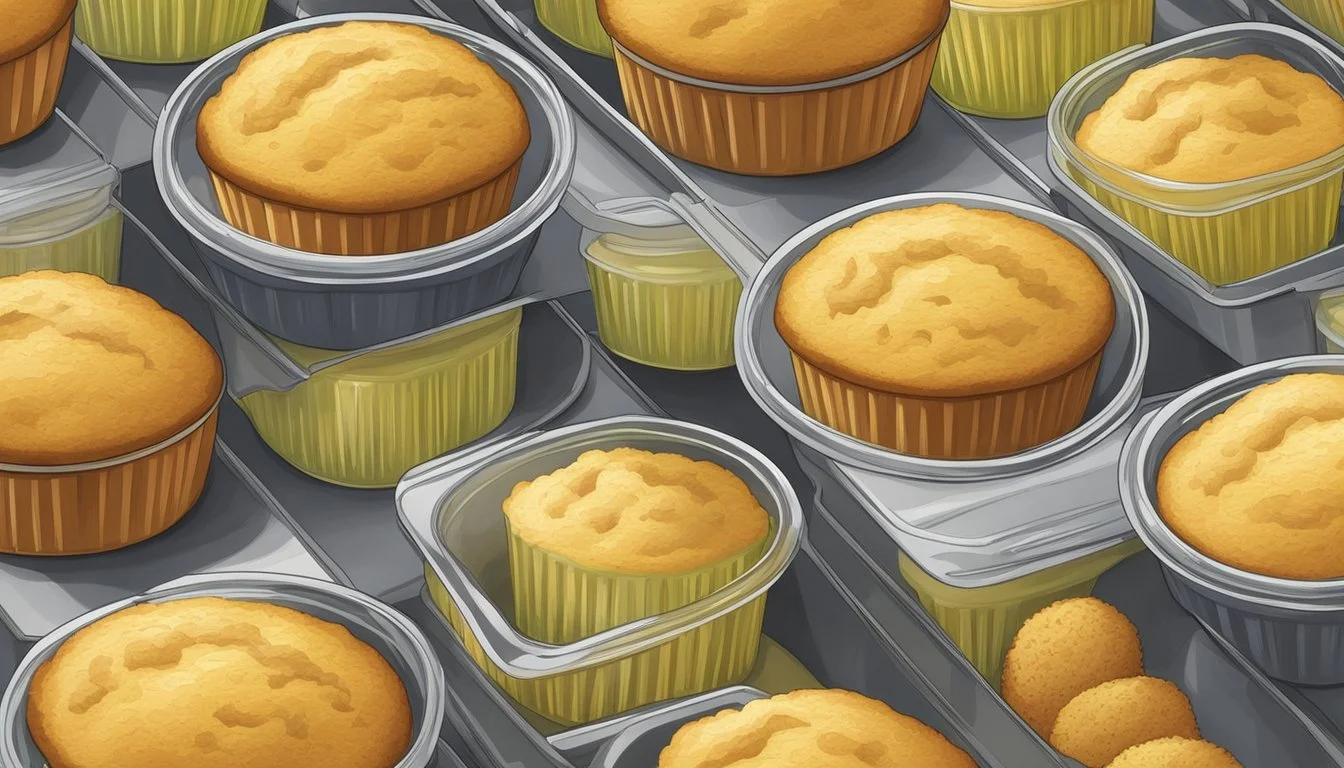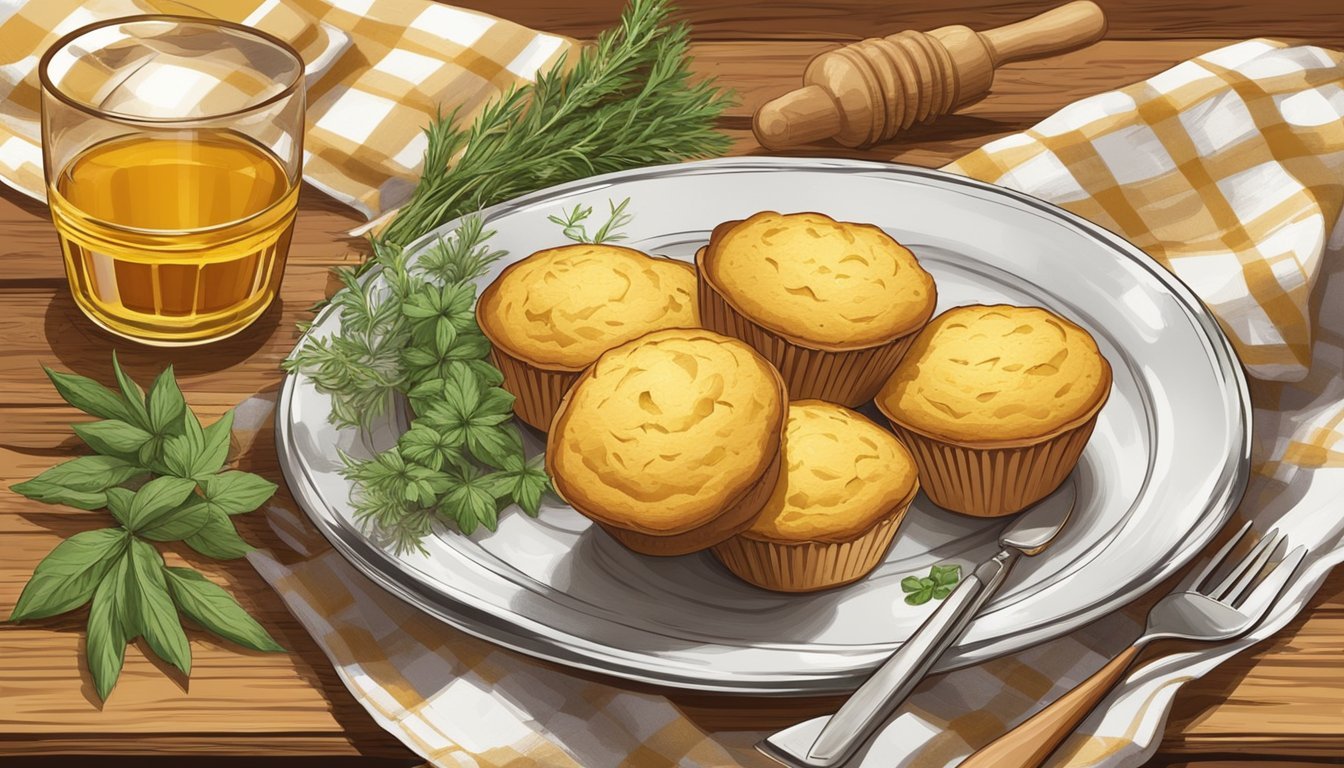Cornbread Muffins Substitutes
Top Alternatives for Every Recipe
Cornbread muffins are a beloved staple in many kitchens, but what happens when the recipe calls for an egg, and you realize you have none? Or perhaps you’re catering to a vegan or someone with an egg allergy. Finding the right substitute for eggs in your cornbread recipe can be crucial to maintaining the perfect texture and taste.
Ground flax seeds offer a fantastic alternative, rich in omega-3 fatty acids, protein, and fiber. Simply blend one tablespoon of ground flax seeds with three tablespoons of water to replace one egg, adding a nutritious twist to your cornbread muffins.
Another excellent option is buttermilk. By mixing 1/4 cup of buttermilk with 1/2 teaspoon of baking soda, you not only replace the egg but also infuse the muffins with a classic, tangy flavor characteristic of traditional cornbread.
Basic Cornbread Muffins Ingredients
Cornbread muffins are a delightful blend of simple ingredients, carefully chosen to balance flavor and texture. The core components include cornmeal, flour, leavening agents, eggs, fats, sweeteners, and liquids.
The Role of Cornmeal and Flour
Cornmeal and flour form the foundation of cornbread muffins. Cornmeal, often medium-grind, provides a gritty texture essential to traditional cornbread. All-purpose flour adds structure and aids in creating a cohesive batter. The typical ratio balances cornmeal's coarse texture with the smoothness of flour, ensuring the muffins have a pleasant bite without being overly crumbly.
Leavening Agents for Lift
Leavening agents like baking powder and baking soda introduce air into the batter, helping the muffins rise. Baking powder is commonly used, sometimes combined with a small amount of baking soda for additional lift if acidic components like buttermilk are used. These agents create a light, fluffy texture, crucial for avoiding heavy, dense muffins.
Binding With Eggs
Eggs play a dual role in cornbread muffins by acting as a binder and contributing to the overall structure. The protein in eggs helps maintain cohesiveness in the batter, preventing the muffins from falling apart. They also provide moisture and a slight richness, enhancing the muffins’ tender crumb.
Fats for Flavor and Moisture
Fats are indispensable for both flavor and moisture. Melted butter gives a rich taste and adds to the tender texture, while oil can be used to keep the muffins moist longer. Unsalted butter is preferred for better control over the salt level in the recipe. The balance of fats ensures the muffins are not dry or bland.
Sweeteners and Flavor Enhancers
Sugar and honey are commonly used to sweeten cornbread muffins. Brown sugar adds a deeper flavor and moistness, while honey imparts a subtle sweetness and nice golden color. These sweeteners not only enhance flavor but also help with browning, contributing to an appealing crust.
Liquids for Batter Consistency
The batter's consistency relies on the right amount of liquids like milk or buttermilk. Whole milk provides enough fat to contribute to the moist texture, while buttermilk can add a tangy flavor and react with leavening agents to boost rise. The liquid component ensures the batter is pourable and bakes evenly.
In sum, these basic ingredients each play a crucial role in creating the perfect cornbread muffins, from texture to taste.
Substitute Ingredients for Dietary Preferences
Finding the right substitute ingredients can ensure that everyone, regardless of their dietary preferences or restrictions, can enjoy cornbread muffins. Here are some key swaps to accommodate various needs.
Vegan Substitutes
Vegans require replacements for both dairy and eggs. Ingredients like vegan butter and vegan mayonnaise can substitute dairy components for a creamy texture.
Aquafaba (the liquid from cooked chickpeas) can replace eggs; use three tablespoons per egg. Other options include silken tofu (1/4 cup per egg), ground flax seeds, or chia seeds (1 tablespoon mixed with 3 tablespoons of water per egg), giving moisture and binding power.
Egg Substitutes for Allergies and Preferences
For those allergic to eggs or who prefer eggless recipes, unsweetened applesauce (1/4 cup per egg) and mashed banana (1/4 cup per egg) offer good binding and moisture.
Egg substitutes like ground flaxseed and chia seeds, as mentioned earlier, are popular for their nutritional value, being rich in omega-3 fatty acids and fiber. Commercial egg substitutes or baking powder mixed with water can also be utilized for a reliable eggless solution.
Dairy-Free Alternatives
Many people avoid dairy for health reasons or dietary preferences. Almond milk and soy milk are great dairy-free substitutes for regular milk.
Vegan butter can take the place of traditional butter, and various milk alternatives like oat milk and coconut milk can add unique flavors and textures. Non-dairy yogurt can also be used to enhance the moisture and richness of the muffins.
Health-Conscious Sweetener Options
For those looking to cut back on sugar or use more natural sweeteners, options are plentiful. Honey is a common substitute for refined sugar, though not vegan. Agave nectar and maple syrup are vegan choices that add a distinct flavor.
Stevia and monk fruit sweetener are low-calorie alternatives. Unsweetened applesauce can also provide sweetness and added moisture without the need for additional sugar.
Healthy Fat Options
Health-conscious individuals may prefer to avoid traditional fats like butter. Olive oil and coconut oil are excellent alternatives that bring healthy fats into the mix.
For a lower-calorie option, applesauce, mashed bananas, or even Greek yogurt can replace part or all of the fat content. These substitutes also contribute additional moisture and a slight sweetness, enhancing the overall flavor profile of cornbread muffins.
Substitution Ratios and Usage Tips
When substituting ingredients in cornbread muffin recipes, accurate measurements and adjustments are key. Implementing the correct ratios and techniques ensures that the muffins maintain their desired texture and flavor.
Measuring Substitutes for Consistency
Measuring substitutes accurately is critical for maintaining the consistency of the batter. Common substitutes include using 1 tablespoon of ground flaxseed mixed with 3 tablespoons of water to replace one egg, which helps bind the batter. Another popular replacement is 1/4 cup of unsweetened applesauce for one egg, adding moisture and a touch of sweetness.
For cornstarch, 1 teaspoon of guar gum can be used as an alternative to thicken the mixture without affecting the texture. Always whisk the dry substitutes properly to ensure an even distribution.
Baking Adjustments for Altitude and Humidity
Baking cornbread muffins at different altitudes and humidities requires specific adjustments. At high altitudes, the baking temperature should be increased by about 15-25°F to stabilize the batter and reduce the baking time by 5-8 minutes. This prevents over-expansion of the batter, which can cause the muffins to collapse.
In humid conditions, it is important to reduce any liquid in the recipe slightly and increase the baking time to account for the added moisture in the air. 2-3 tablespoons less liquid can help achieve the right batter consistency.
Mixing Techniques for Substitutes
Mixing the batter correctly when using substitutes ensures a smooth texture and even distribution of ingredients. It’s recommended to whisk together dry ingredients first to break up any clumps. When incorporating wet substitutes like applesauce, blend them thoroughly with the wet ingredients before combining with the dry mix to avoid over-mixing, which can make the muffins dense.
Using a spoon or a cookie scoop, measure the batter into muffin tins to ensure uniform sizes. For added moisture, let the batter rest for 5-10 minutes before baking, allowing the substitutes to fully integrate and improve texture.
Each of these steps helps create the perfect cornbread muffin, even when using alternative ingredients.
Flavor Variations and Add-Ins
Cornbread muffins not only serve as a delightful staple but also offer immense versatility through various add-ins, allowing for a myriad of sweet and savory flavors. Exploring different ingredients can transform a simple cornbread muffin into an extraordinary culinary experience.
Sweet and Savory Cornbread Muffin Versions
Cornbread muffins can be tailored for both sweet and savory preferences. For a sweet version, consider adding sugar, vanilla extract, or maple syrup to the batter. Honey or brown sugar can also enhance sweetness.
For a savory twist, ingredients such as jalapeños, scallions, or cheese can be incorporated. Corn kernels add texture and a subtle sweetness, while crumbled bacon or chorizo can deliver a rich, savory depth. Spices like cumin or smoked paprika can provide a flavorful kick.
Mixing these ingredients judiciously ensures the muffins retain their balance and do not become overwhelming, catering to diverse palettes in a single batch.
Inclusion of Grains, Seeds, and Nuts
Enhancing cornbread muffins with grains, seeds, or nuts boosts both texture and nutritional value. Chia seeds and flaxseeds are excellent additions for an added crunch and nutritional benefits such as omega-3 fatty acids.
Adding sesame seeds or poppy seeds can offer a subtle nutty flavor. For a hearty touch, consider sunflower seeds or pumpkin seeds.
Nuts like chopped pecans, walnuts, or almonds introduce a satisfying crunch and a slightly sweet, earthy flavor. These ingredients not only enhance texture but also provide additional protein, making the muffins more filling and nutritious.
Mixing in Fruits and Vegetables
Incorporating fruits and vegetables into cornbread muffins is a fantastic way to introduce natural sweetness and fresh flavors. Fresh or frozen berries like blueberries or cranberries add a burst of sweetness and tartness.
Fruits like corn kernels, apples, and bananas can also enhance the muffin's moistness and flavor profile. Meanwhile, vegetables such as zucchini, carrots, or sweet potatoes provide a delightful earthy taste and boost the muffin's nutritional content.
Such variations make cornbread muffins adaptable for every meal, from breakfast to dinner, ensuring they are both delightful and wholesome.
Storage and Preservation of Cornbread Muffins
Properly storing and preserving cornbread muffins is essential to maintaining their freshness and quality. Depending on your method, you can extend their shelf life and enjoy them longer without sacrificing taste or texture.
Tips for Freezing and Reheating
When freezing cornbread muffins, ensure they are completely cooled before placing them in an airtight container. This prevents moisture buildup and freezer burn. They should be individually wrapped in plastic wrap or aluminum foil to maintain quality.
Reheating frozen muffins requires preheating your oven to 350°F (175°C). Place the muffins on a baking sheet and bake for 15-20 minutes for frozen muffins, or 10 minutes for refrigerated ones. This preserves their texture and taste without drying them out.
Maintaining Freshness After Baking
Allow freshly baked cornbread muffins to cool completely before storage. Use an airtight container to keep them in the pantry, making sure to separate each muffin with parchment paper to avoid sticking.
The storage location impacts freshness. For short-term storage, keep them in the pantry, and they will last for about 2-3 days. For longer preservation, use the refrigerator, extending their shelf life to up to a week. Proper cooling and sealing preserve taste and texture, preventing staleness.
Shelf Life Expectancy for Substituted Ingredients
Substituting ingredients in cornbread muffins, such as using gluten-free flour or dairy-free milk, can slightly affect their shelf life. Gluten-free muffins may dry out quicker, so refrigeration is advisable.
Using honey or other natural sweeteners can also impact preservation. These substitutes tend to retain moisture better, slightly prolonging freshness. On the other hand, using fruits or vegetables, like adding corn kernels, might introduce extra moisture, requiring them to be stored in the refrigerator to prevent spoilage.
Understanding these variations can help in choosing the right storage method for substituted cornbread muffins, ensuring they remain delicious and fresh.
Cornbread Muffins Serving Suggestions
Cornbread muffins are incredibly versatile and can complement a wide array of main dishes. They can also be enhanced with various creative toppings and spreads, making them suitable for diverse cuisines, including Southern and Southwestern variations.
Pairings with Main Dishes
Cornbread muffins are a classic side dish for chili, where their slight sweetness contrasts beautifully with the savory, spicy stew.
They also pair well with barbecued meats like ribs, brisket, and pulled pork. In addition, these muffins can be a tasty companion to southern favorites such as fried chicken, catfish, and collard greens.
For lighter meals, serve them with hearty salads or soups like tomato bisque or vegetarian stew.
Creative Toppings and Spreads
Enhancing cornbread muffins with toppings and spreads adds an extra layer of flavor and texture.
Honey butter is a traditional favorite, blending sweetness with creamy richness. Jalapeño jelly provides a spicy kick, perfect for those who enjoy a mix of heat and sweet.
Consider topping them with shredded cheese, bacon bits, or scallions for a savory twist. For a sweeter option, use fruit preserves, cinnamon butter, or Nutella.
Southern and Southwestern Variations
Southern cornbread muffins typically focus on simplicity, allowing the cornmeal's natural flavor to shine.
They might include ingredients like buttermilk and a hint of sugar. On the other hand, Southwestern versions often feature add-ins such as chopped jalapeños, corn kernels, and shredded cheddar cheese for a vibrant burst of flavor.
These variations pair well with dishes that have bold spices and robust flavors, enhancing the overall meal experience.
Using these suggestions, cornbread muffins can be both a comforting staple and a canvas for creative culinary exploration.
Common Questions and Expert Tips
Understanding the nuances of baking cornbread muffins can lead to consistently delicious results. Here, we address common questions and provide expert tips to help you achieve the perfect consistency.
Troubleshooting Cornbread Muffin Baking Issues
Muffins are too dry: If your cornbread muffins turn out dry, it could be due to overbaking or not enough moisture in the batter. Check the muffins a few minutes before the recommended baking time by inserting a toothpick; it should come out clean but not dry.
Muffins stick to the liners: To prevent sticking, ensure you coat paper liners with nonstick spray or opt for silicone liners, which release muffins more easily.
Muffins are too dense: A dense texture might result from overmixing the batter. Mix just until ingredients are combined to maintain lightness. Also, measure baking powder and soda accurately as too much or too little can affect the rise and texture.
Muffin tops sink: This often occurs due to opening the oven door too early or using expired leavening agents. Ensure your baking powder and soda are fresh, and avoid disturbing the muffins until they are nearly done.
Expert Advice for Perfect Consistency
Use accurate measurements: Weigh your ingredients for consistency and reliability. Flour should be spooned into the measuring cup and leveled off, not packed.
Combine wet and dry ingredients properly: Whisk dry ingredients (flour, baking powder, baking soda, salt) in one bowl, and wet ingredients (butter, egg, milk) in another. Combine them gently to avoid overworking the batter.
Check oven temperature: An oven thermometer is valuable for ensuring accurate baking temperatures. Cornbread muffins bake best at 400°F (200°C) but verify to avoid under- or over-baking.
Add moisture: Ingredients like sour cream or yogurt can add extra moisture to your muffins. This helps to keep them soft and tender.
These tips are designed to help you correct and avoid common issues while ensuring your cornbread muffins have the perfect consistency every time.






